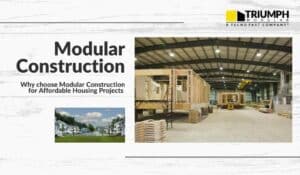Triumph’s “submittals” guardrail requires that our contracts define submittals prior to signature. By doing so, projects run smoother.
Although submittals may seem straightforward, it could be one of the most misunderstood and poorly defined issues in all of the construction, often leading to disputes and delays. At Triumph, we’ve seen that a discussion of submittals, prior to executing a final contract, has given many benefits to our clients.
To look at submittals in more depth, the easiest place to start is examining them in a classic Design-Bid-Build context. In these types of projects, a designer has taken the trouble to meet with an owner to design a building with every last detail committed to a set of plans. Designing requires months of time and several stages from “conceptual designs” through further detailing, often called “design development.”
The design process results in a set of plans which serve several critical purposes, including:
- providing the necessary information for permitting
- instructing builders with enough detail that they can provide a fixed price
It, therefore, makes sense that the builder — hired to build the design — should prove to the designer and owner, at various stages of the build, that they are building according to the plans.
This presupposition holds true even when the builder is involved with the designer in creating the plans, which is a requirement for successful modular projects. In these cases, there are still details in the specification that may not be in the drawings for construction. Submittals, therefore, protect all parties as a means for clarification.
Color selection is an example of a detail that may be in the submittals, but not in the drawings or base contract documents. This shows how submittals can help avoid serious surprises. By spelling out in detail how the builder will obtain owner approval, submittals force the builder to verify that he or she is moving ahead only with materials and systems that will meet the owner’s expectations.
Another benefit of submittals is the submittal log. The submittal log creates the owner’s operations and maintenance manual as cut sheets of systems, including HVAC units, windows, and appliances. This manual tells the owner how to use or replace every element, moving part, and system in their new building.
The benefits of submittals are abundant, but here is the catch: The only way to realize these benefits is for the parties to discuss submittals in advance of the contract.
When discussing submittals, I recommend 3 key questions:
- What will be submitted?
- Which ones will be for record only versus for owner approval?
- And why?
These 3 questions alone, when discussed with a healthy team, will make for a smoother, faster, and happier project for everyone involved.
The second question above is an important one because in some cases it is okay to limit the items needed for approval. A good example of this is when the owner has worked with the builder in the past and there is already a high degree of trust. In this case, the owner still gets a complete operations manual, but the builder can reduce fees because submittals have been limited.
Most projects have detailed architectural drawings that define the work for the builder, so some projects could suffice with a limited list of “for approval” submittals. It’s all about meeting owner expectations. By asking the owner what they think about submittals before the contract is signed, it will reveal a lot about the project overall, from the role of the architect to project budgeting.
Given Triumph’s focus on modular constructions, we have found that we operate in design, build and collaborative forms of contracting. In these types of projects, as an expert modular builder, we are asked to help in design, and as a result, the rules of who will make the submittal log and what will be on it, become less clear. If it’s unclear whether submittals will be for record only, this should be clarified before contracts are finalized.
Regardless of contracting type, submittals can slow down a project if people are not paying attention. Particularly in modular construction, we cannot accept a submittal log for owner approval that will slow down the modular factory. We need to be sure that our contracts define submittals in a way that places an obligation on the owner (or their architect) to return certain long-lead items by a particular date.
Construction is complex enough. I encourage builders and owners alike to be courageous: broach the subject of submittals in the planning stage of your next project, prior to forming any contract. I know you will find it helpful.
Continue to Cone 6 — Closeout | Introduction to Guardrailed Construction




